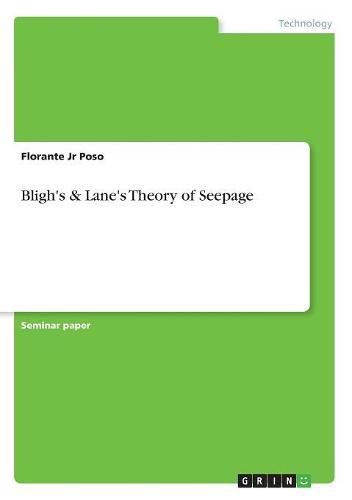Readings Newsletter
Become a Readings Member to make your shopping experience even easier.
Sign in or sign up for free!
You’re not far away from qualifying for FREE standard shipping within Australia
You’ve qualified for FREE standard shipping within Australia
The cart is loading…






This title is printed to order. This book may have been self-published. If so, we cannot guarantee the quality of the content. In the main most books will have gone through the editing process however some may not. We therefore suggest that you be aware of this before ordering this book. If in doubt check either the author or publisher’s details as we are unable to accept any returns unless they are faulty. Please contact us if you have any questions.
Seminar paper from the year 2017 in the subject Engineering - General, Basics, grade: 1.5, University of Eastern Philippines, course: Civil Engineering, language: English, abstract: To prevent internal erosion and particle migration, control of seepage pressures and velocities must be given due consideration in the design of hydraulic structures. The percolation length (seepage) for a foundation can be determined by using various methods. There are number of methods available to analyze the problem on seepage and uplift pressure, and one of which is Bligh’s theory of creep. Other methods are Lane’s Method, Kosla’s Theory and Flow nets. Based on Bligh’s theory, that along the bottom contour of the structure, the water creeps, and the percolation length (seepage) can be determined. Lane’s theory was patterned from the Bligh’s creep theory but according to Lane, Bligh had only calculated the total length of creep by adding both the horizontal and vertical length of creep and part of its limitation is it does not make any distinction between the two creeps. Some experts had criticized Lane’s method due to the fact that it is an empirical method and not based on any mathematical approach. However, the method is also widely used due to the simplicity on its approach.
$9.00 standard shipping within Australia
FREE standard shipping within Australia for orders over $100.00
Express & International shipping calculated at checkout
This title is printed to order. This book may have been self-published. If so, we cannot guarantee the quality of the content. In the main most books will have gone through the editing process however some may not. We therefore suggest that you be aware of this before ordering this book. If in doubt check either the author or publisher’s details as we are unable to accept any returns unless they are faulty. Please contact us if you have any questions.
Seminar paper from the year 2017 in the subject Engineering - General, Basics, grade: 1.5, University of Eastern Philippines, course: Civil Engineering, language: English, abstract: To prevent internal erosion and particle migration, control of seepage pressures and velocities must be given due consideration in the design of hydraulic structures. The percolation length (seepage) for a foundation can be determined by using various methods. There are number of methods available to analyze the problem on seepage and uplift pressure, and one of which is Bligh’s theory of creep. Other methods are Lane’s Method, Kosla’s Theory and Flow nets. Based on Bligh’s theory, that along the bottom contour of the structure, the water creeps, and the percolation length (seepage) can be determined. Lane’s theory was patterned from the Bligh’s creep theory but according to Lane, Bligh had only calculated the total length of creep by adding both the horizontal and vertical length of creep and part of its limitation is it does not make any distinction between the two creeps. Some experts had criticized Lane’s method due to the fact that it is an empirical method and not based on any mathematical approach. However, the method is also widely used due to the simplicity on its approach.